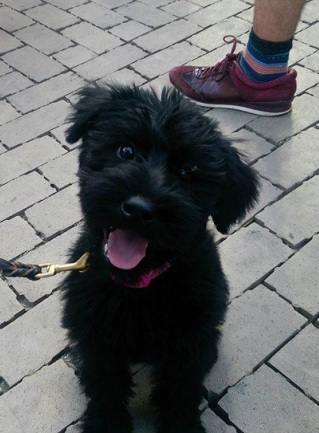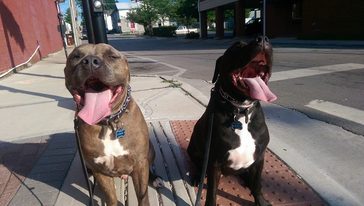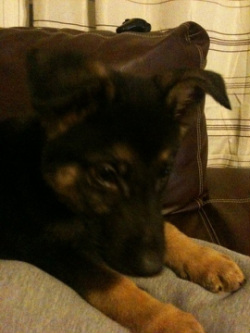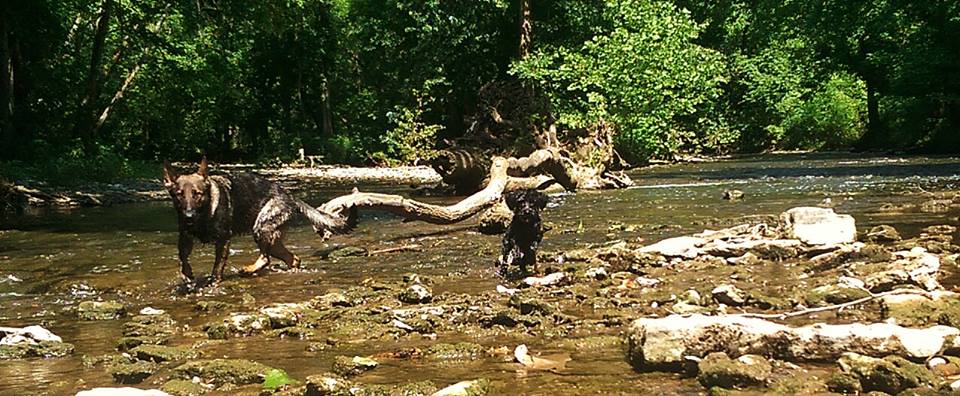 When most people have an interaction with dog trainers they aren't aware that the dog may be working at the time or have a different idea of how you should interact. Generally speaking when people run into me and a dog they will try to interact with the pup. Most people know the general things that will help like crouching or holding their hand out for an inspection but do you know how to maximize your interactions? I wanted to write this to help people who want a better connection with most dogs they meet.
Adam Madore
professional dog trainer with Artisan dog training Lexington / Nicholasville
1 Comment
Dogs are social animals that appreciate being understood as much as anyone so sometimes when we are baffled by our pets behavior we may need to look at the basics again. I have a lot of clients who come to me with no way to communicate with their dogs and feel like it's the fault of the dog or the clients blame themselves. Instead of blaming yourself you simply improve you communication and you will see results right away. I've decided to write down some of my favorite ways to increase communication and improve your skills with simple exercises.
Adam Madore
professional dog trainer with Artisan dog training Lexington / Nicholasville 3/5/2014 0 Comments To rescue or buy? One of the things that makes America great is all the choices we have today. When buying a dog the sky is the limit. You can choose from color,breed, and even temperament. I am a huge advocate for dog ownership in any form but I would like to talk about the major differences and what to know. When selecting a purebred dog you will run into many complications and these can really affect what kind of dog you get. Starting with general ideas you will have two basic differences in every breed. Working line and show line. Working line dogs are built to be strong tenacious and intelligent. Show lines are meant to be she epitome of the breed in all conformation(looks). Knowing your breed and the inherent illnesses that the breed is affected with can also change your mind. I usually choose working lines because of my profession, but that is not always what you may read about the breed. A good example is the dachshund. They are great with kids and very sweet but some working lines are very energetic and can wear down most children even. I could expand upon this subject for days but we will move on. For questions about your breed feel free to contact me. Show lines are usually very good examples of the breed and fit the descriptions. If you decide to get a rescue dog from a shelter or an organization you should still do your homework. Start by having a good generalization in mind. Big,small, calm, or ,excited. Stick to the plan and take your time. Most of the shelters are going to have plenty to choose from and they are always a good bargain. Adam Madore
professional dog trainer with Artisan dog training Lexington / Nicholasville 7/3/2013 3 Comments Socializing your puppy While I was studying to be a dog trainer I learned extensively about socializing dogs. I can't convey the large amount of knowledge here in a short blog post or even in a single lesson. What I will be covering today is summary of some things and a condensed version of others. If your raising a puppy for a certain job you will need to contact me directly or put it on my facebook page. Socializing your dog is generally speaking taking your dog out and exposing him or her to variable scenarios. Introducing new things and experiences in order to amplify your dogs confidence and help them develop without fear of the world around them. Some of you worry about what may happen when you are socializing your puppy. The most common fear is will they come down with some random malady. When your puppy has not finished its round of shots you do have to protect them or they certainly can come down with something possibly fatal. The benefits to your puppy Vastly outweigh the negatives in my eyes because of the amount of control that you can exert over them when they are going somewhere. When a puppy grows from 8 weeks to 12 weeks the puppy isn't really afraid of anything and it would take a rather extreme issue in most puppies minds in order for them to become wary of something. After this short window they will begin to become suspicious of things, people, or other animals. When your choosing places to take your new furry friend remember that they can become overloaded and stressed. If you take them somewhere that is busy or chaotic then they will have a shorter amount of time to take it all in before they need to leave or could become too overloaded and create stress issues. Signs of stress are a puppy licking their lips repeatedly or yawning. More obvious ones like shaking or cowering could present themselves too but don't swoop in right away and evacuate with your puppy just give them a moment to recover. If you are going around other dogs you should be mindful of the other dog and be cautious. Be certain that they do not touch lots of random dogs and puppies. DO NOT TAKE THEM TO DOG PARKS. When you expose a puppy to the dog park they have a Far greater chance to get sick. Many people don't have vaccinations on their dogs or they are not up to date and could harm your puppy. If your puppy is small enough then carrying them around and letting people pet them is a good idea and I be sure to watch my facebook page to find out about things going on in your area that your dog and you would want to do. Adam Madore
professional dog trainer with Artisan dog training Lexington / Nicholasville 5/2/2012 0 Comments Social AnxietyMany of my customers lately are asking about their dog having some social anxiety. If this sounds like you I have a few little tips for you. Does your dog go crazy as soon as you leave the house? Do they wait until you've been gone for a while? Do they have a lot of toys or things to keep them busy? If you don't know for sure then you can leave a recorder or some kind of device and find out. If they are going crazy as soon as you leave then you will have to work on their anxiety. If your dog waits until you have been gone for a while then they may just not have enough to do! The last question is does your dog piddle in the kennel? it may be time to restrict water before bed. Place some scraps of paper under or in the kennel and see if they have been wet. Next time I will talk about helping your dog cope with anxiety. Adam Madore
professional dog trainer with Artisan dog training Lexington / Nicholasville It does not matter if your dog is chewing a little or chewing a lot, before your dog trainer shows up there are a few things you can do to alleviate this issue. First and foremost you can get your dog something else to chew. If your dog doesn't like his new toy he will not stop chewing your shoe/couch/face or whatever he has found. Pay close attention to your dog when she is free to roam the house. If you can't watch them you can't control them. If your dog has a chance to chew up something they can fall back into bad habits. Figure out the motivation. Most of the time this is when people call me is when they have tried everything and nothing is working. If the they have separation anxiety or maybe they are just having fun it can be a little difficult to know. You have to set them up and observe them to find out! thank you for reading today. Adam Madore
professional dog trainer with Artisan dog training Lexington / Nicholasville 4/10/2012 1 Comment Teaching your puppy not to biteTeaching a puppy can be very different from teaching a dog in many ways. Puppies have a very limited viewpoint and need to be taught to discern right from wrong. We love to play with our puppies but a puppy wants to play with us as it will with other puppies. The most prevalent ways to stop this behavior will be laid out in this article. First and foremost is to let your puppy know that biting is not ok and will not achieve positive results. When the puppy bites you can yelp loudly and jerk your hand away. Another way is to grab the puppies lower jaw under his tongue and with your pointer finger and hold for a few seconds. The puppy will pull back and then you let him go. Continue as necessary. The third and final way is with positive reinforcement. You can place a toy between you and the puppy, which allows him a reward and something else to chew on. If he is teething use ice. You may also reward him in your treat training for not biting. Depending on the customer or the puppy these are my usual methods. Except method two, it is rarely called for or needed. Thank you for your time and as always feel free to contact me with any questions. Adam Madore
professional dog trainer with Artisan dog training Lexington / Nicholasville 4/10/2012 1 Comment Dealing with an aggressive dogI have been bitten many times growing up. I learned a lot about not having that process repeated. After I became a dog trainer I found that a lot of people are needlessly injured by dog bites every year. I'm going to start by laying down rules 1) Never simply approach a strange dog. You don't know this dog or what he may do once you are close enough to reach. 2) Always ask permission of the owner. If they have an aggressive dog they are usually pro-active about letting strangers approach but anyone can be caught unaware. 3) If the dog is showing signs of aggression definitely do not approach them. If they are roaming loose call the dog warden. 4) Do not hover or make sudden movements. Even when a dog is not normally aggressive someone hovering over them or rushing into them may be seen as a threat. 5)Don't attempt to corner a dog. Even if you are trying to help all they understand is they can only escape past or through you. 6) In the event you are attacked do not run. Many dogs may bite and then stop right away. If you run they will chase you so simply walk away and do not stare at them. These are just general guidelines to help you in the event of most dogs. Many situations will differ but these rules will frequently apply to most dogs. Above all be aware and stay safe! Adam Madore
professional dog trainer with Artisan dog training Lexington / Nicholasville 3/20/2012 1 Comment Dog trainer general tipsWhen I first started training it took me very little time to find out that puppies can be destructive and dogs are hard on toys. I also found out that the better nutrition I fed my high end puppies the better they could progress. I really like any toy that can withstand a Belgian Malinois puppy. Most of my toys come from Bluegrass Barkery they also sell Taste of the wild dog food, you can find them at http://www.bluegrassbarkery.com/HOME.html . If you like to order your things online my favorite place from a dog training point of view is http://www.indestructibledog.com/ and their dog beds are fantastic, also if you sign up for their email they will have you try out the products they are reviewing. My favorite dog and puppy foods can be found at http://www.tasteofthewildpetfood.com/ and http://www.diamondpet.com/ if you have any suggestions let me know and I'll post them and try them. Adam Madore
professional dog trainer with Artisan dog training Lexington / Nicholasville |
AuthorAdam Madore is a dog trainer with a passion for training and dogs in general. Archives
July 2014
CategoriesAll Aggressive Dogs Anxiety Chewing Contest Dog Training Drawing Faq Feeding Food Free General Obedience General Tips Gift Card Potty Training Puppy Seperation Socialization |
Search by typing & pressing enter



 RSS Feed
RSS Feed
